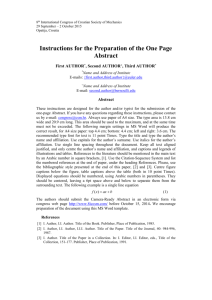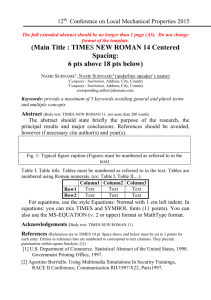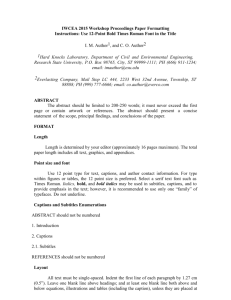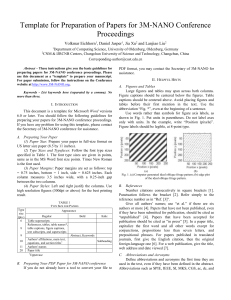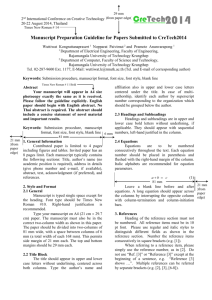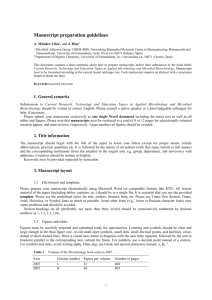Word
advertisement
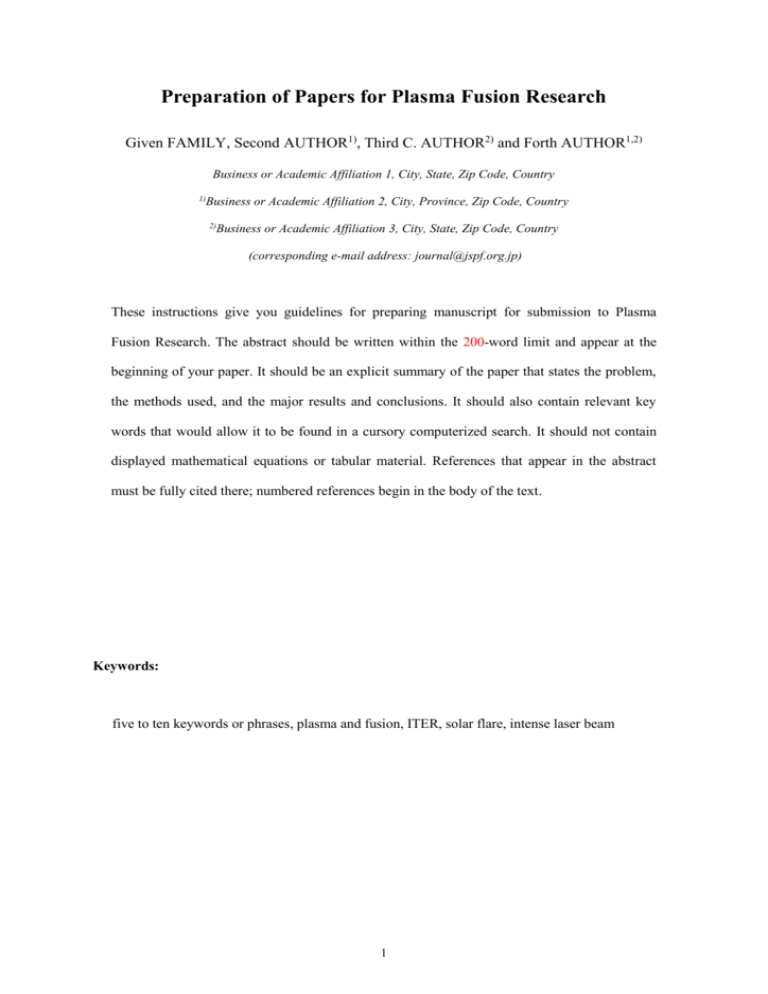
Preparation of Papers for Plasma Fusion Research Given FAMILY, Second AUTHOR1), Third C. AUTHOR2) and Forth AUTHOR1,2) Business or Academic Affiliation 1, City, State, Zip Code, Country 1) Business or Academic Affiliation 2, City, Province, Zip Code, Country 2) Business or Academic Affiliation 3, City, State, Zip Code, Country (corresponding e-mail address: journal@jspf.org.jp) These instructions give you guidelines for preparing manuscript for submission to Plasma Fusion Research. The abstract should be written within the 200-word limit and appear at the beginning of your paper. It should be an explicit summary of the paper that states the problem, the methods used, and the major results and conclusions. It should also contain relevant key words that would allow it to be found in a cursory computerized search. It should not contain displayed mathematical equations or tabular material. References that appear in the abstract must be fully cited there; numbered references begin in the body of the text. Keywords: five to ten keywords or phrases, plasma and fusion, ITER, solar flare, intense laser beam 1 1. Introduction Plasma and Fusion Research is an electronic journal published monthly by the Japan Society of Plasma Science and Nuclear Fusion Research. The journal, covering the wide disciplines of plasma science and technology, is intended to provide an accessible and comprehensive source for analysis and contemporary information and data in every area of plasma and fusion research. 2. Manuscript Submission Guidelines This document is a preprint-image for Microsoft Word versions 6.0 or later. Author(s) may use this Word file as a style guide to prepare his/hers/their manuscript. When Author(s) submit the manuscript, he/she/they should convert the Word file into PDF format. Using a journal-page sample file author(s) is recommended to check total length of the manuscript in a printed image, equations (especially lengthy equations to be separated into multiple lines), tables and figures (font sizes should be cheched), and references. If you are reading a paper version of this document, please download the electrical file from http://www.jspf.or.jp/PFR/sample.html. If you would prefer to use LATEX, download a style file of PFR and sample files from Web page. PFR recommend Postscript font for preparation of manuscript. However if these font are not installed on your computers, font replacement like Time => Times New Roman, Symbol (Postscript) => Symbol (True type), Helvetica => Arial is accepted. This style guide has been written to allow authors to use almost any word processing, page layout, or typesetting software that can print to a PostScript printer or output PostScript to a file. It is essential to use an appropriate PostScript printer driver to generate the compuscript file for submission. Most, but not all, PostScript printer drivers will generate proper output. Please see the help files of JSPF Web page for information on recommended drivers and installation instructions. The length of Rapid Communications and Letters should not exceed 2 pages and 4 pages in a printed image, respectively. Paper size should be A4 (21.0 x 29.7 cm). The length of an article can be calculated by allowing 900 words per page in an A4-sized journal. When you submit your final version, check the total length of your paper in a printed image, including figures and tables. 2 All fonts for text should be Times or Times New Roman and Symbol. Text should be 11 pt., the title should be 16 pt., and the affiliation should be 10 pt in the submission form. Do not use hyphenations for the end of a line. The line spacing of main text should be double-spacing. Major headings (“Head 1” in the template style list) are bold 11-point font, flush left, and numbered (1. 2. 3. etc.) Subheadings and Sub-Subheadings are bold, flush left, and numbered as 1.1, 1.2, etc. and as 1.1.1, 1.1.2, etc., respectively. In Rapid Communications and Letters, section headings may not be necessary or permitted. The first line of the first paragraph of a section or subsection should start flush left. The first line of subsequent paragraphs within the section or subsection should be indented 7 mm. All acronyms and abbreviations should be clearly explained when they first appear in the text, and all units used should be consistent throughout the article. When you open sample_p.doc, select "Page Layout"(“Insatsu Layout”) from the "View"(“Hyouji”) menu in the menu bar. Then type over sections of this file or cut from another document and paste and then use markup styles. The pull-down style menu is at the left of the Formatting Toolbar at the top of your Word window (for example, the style at this point in the document is "Text"). The style will adjust your fonts and line spacing. 2.1 Fonts Latin letters used as symbols that represent quantities are generally italicized, whereas units and abbreviations for chemical elements, etc., should all be in ordinary roman type. Vectors are generally in bold italic, with tensors in sans serif. Latin-letter superscripts or subscripts on physical quantities or numbers should be italicized. However, if a superscript or subscript is an abbreviation of a word, roman type should be used. 2.2 Units The choice of units and the way to write them should, in general, follow the rules of the Systeme International (SI) of metric units. It is advisable that units of the CGS and SI Systems not be used together. 3 The symbols (or abbreviations) for units should appear in ordinary roman type. In general, lowercase letters are to be used, although symbols derived from proper nouns will have their first letter capitalized (e.g., J and Hz). Do not put a period after the abbreviation for a unit, and use the same form for singular and plural. 2.3 Equations Use either the Microsoft Equation Editor or the MathType add-on for all math objects in your paper. "Float over text" should not be selected. A math object is any equation or fragment containing mathematical symbols (including Greek characters, superscripts and subscripts) that appears either inline (in the flow of normal text) or as a display equation (in its own space between lines of text). In particular, you should avoid using Word fonts or symbols for in-line single variables with superscripts or subscripts. Use italics for emphasis; do not underline. The MathType add-on for Word is a commercial product. If you have MathType, use it for as much of your math as possible. If not, use the Microsoft equation editor, which comes as part of Word. Equations should be indented 10 mm. Equation numbers should appear at the right-hand margin, in parenthesis. For long equations, the equation number may appear on the next line. For very long equations, the right side of the equation should be broken into approximately equal parts and aligned to the right of the equal sign. The equation number should appear only at the right hand margin of the last line of the equation. For example, ~ f (x, , E) ρ f M (x, E), (1) where ρ b v / . r2 0 Fij (r , )dr d r2 2 0 0 exp z j z i 1 J 1 r2 d . (2) Be sure that the symbols in your equation are defined before the equation appears, or immediately following. Italicize symbols (T might refer to temperature, but T is the unit tesla). However, simple expressions may be left in the text on one line, e.g., E = m c 2. 4 Refer to “Eq. (1),” not “(1)” or “equation (1)” except at the beginning of a sentence: “Equation (1) is…” Equations can be labeled other than “Eq.” should they represent inequalities, matrices, or boundary conditions. If what is represented is really more than one equation, the abbreviation “Eqs.” can be used. 2.4 References The references should be both necessary and sufficient in extent. Avoid citing references that are unavailable to the general public, such as private communications or preprints; instead it is preferable to state their source and specific content, either within the text or in a footnote. PFR uses numerical notations in brackets for bibliographic citations. Indicate references by means of consecutive numbers, such as Spitzer [1], Artsimovich [2,3], Chandrasekhar [4-6], etc., and list them all together at the end of the paper. It is preferable that each number corresponds to only a single reference. At the point of citation within the main text, designate the reference by typing the number in after the last corresponding word [1]. Reference numbers should precede a comma or period [2]. Two references [3,4], should be included together, separated by a comma, while three or more consecutive references should be indicated by the bounding numbers and a dash [1-4]. References should be cited according to the PFR reference style (see the “References” section of this template). 2.5 Figures, Tables, and Captions The figures, along with the photographs must be numbered consecutively with Arabic numbers, such as Fig. 1, Fig. 2, etc. Letters in figures must be sufficiently large. The size of a figure should be commensurate with the amount and value of the information conveyed by the figure. PFR accepts video and audio as separate files. Color printing of figures is also available. If you want to use color figure on paper printing, this cost shall be billed to the authors. All figures should have their captions. Captions should be listed in the separate paragraph and are not written with the graphics in the submission form. When citing a figure in the text, use the abbreviation “Fig.” except at the beginning of a sentence. Your figures should be numbered in the order in which they are referred to in the text. If there is more 5 than one part to a figure (e.g. figure 1(a), figure 1(b) etc), the parts should be identified by a lowercase letter in parentheses close to or within the area of the figure. Separate tables (numbered with Roman numerals in the order of their appearance in the text) should be used for all but the simplest tabular material; they should have captions that make the tables intelligible without reference to the text. Do not abbreviate “Table” in the text. (e.g. Table1, etc.) The structure should be clear, with simple column headings giving all units. Footnotes to the table should be indicated by superscripts, a, b, c, etc., and begun a new for each table. Tables should appear on separate pages after the references. 3. Conclusion / Summary A conclusion or summary section is not required, though it is preferred. Although a conclusion may review the main points of the paper, do not replicate the abstract as the conclusion. A conclusion might elaborate on the importance of the work or suggest applications and extensions. Note that the conclusion section is the last section of the paper that should be numbered. The acknowledgment, appendix (if present), and references should be listed without numbers. Acknowledgments Acknowledgments should appear under that heading at the end of the main text (before the appendices, footnotes, tables, figure captions, and figures, if any). Acknowledgment of financial support should appear as the last paragraph under the same heading. The preferred spelling of the word “acknowledgment” in American English is without the “e” after the “g.” Avoid expressions such as “One of us (S.B.A.) would like to thank…” Instead, write “F. A. Author thanks…” Appendix An appendix, if needed, should appear after the acknowledgements. 6 References Each reference should contain (in this order) the author's name, nameof the journal, volume number (in bold type), page number, and year of publication (in parentheses). For journals that are not paginated consecutively throughout the volume, also include the issue number. Follow the conventions of ISO/833 for abbreviating the names of journal. In papers written in English, when citing a reference written in a language other than English), indicate the name of the journal by means of romanized 1etters or by the English name for the journal, and at the end of the reference indicate the language used: e.g., [in Japanese] or [in Russian]. References that are not yet published, but which are set to be published, may be designated in the bibliography as "to be published in [name of journal], [volume number], and [year (in parentheses)]." The volume number, year, and page number may be included at the time of proofreading if this information can be obtained by then. References to books should contain (in this order) the author's name, book title (italicized), editor's name, publisher's name, publisher's location, year of publication, and chapter or page number. The name of the publisher, his location, and the year of publication should be inside parentheses. References to proceedings should be identical in form to book citations. If you have any question for this style, please contact to the publication office of PFR (journal@jspf.or.jp). Some examples are shown in the following: [1] M. D. Kruskal and R. M. Kulsrud, Phys. Fluids 1, 265 (1985). [2] L. Spitzer, Jr., Physics of Fully Ionized Gases (Interscience Publishers, Inc., New York, 1959) p. 20. [3] S. Tanaka, to be published in Jpn. J. Appl. Phys. 22 (1983). [4] K. Yamamoto, Kakuyugo Kenkyu 51, 5 (1984) [in Japanese]. [5] Y. Kitazawa and K. Sugiyama, JPFR 16, 40 (2001). [6] Z. Yoshida et al., PFR 1, 1 (2006). 7 Figure Captions Fig. 1 Figure captions should be listed in separated pages after the main text. Fig. 2 Captions for the sample figure. Figures are attached at the end of the submitting manuscript. 8 I sat (A) 0.3 0.2 0.1 0 2.6 2.8 3 time (s) 3.2 Fig.1 by F.Author, et al. 9
